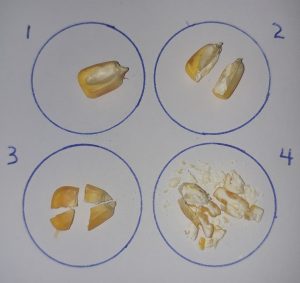– Dr. Francis L. Fluharty, Research Professor, Department of Animal Sciences, The Ohio State University
Acidosis is a prerequisite to classic feedlot bloat. Acidosis is most prevalent when high-grain diets are fed.

1) whole corn kernal; 2) whole corn kernal split in half; 3) whole corn kernal quartered; 4) one whole corn kernal broken into many smaller pieces. Each time corn or other grains are ground or split further the total surface area of the feed increases, and the rate of ruminal fermentation is increased.
When cattle are over-fed large amounts of starch Streptococcus bovis bacteria that make lactic acid increase rapidly. In this instance, bacteria that use lactic acid (Megasphaera elsdenii, Selenemonas ruminantium, and Selenomonas lactilytica) cannot keep up with production of the lactic acid.
The normal rumen pH with cattle fed high-grain diets is between 5.5 and 6.2, but when lactic acid is over-produced, the rumen pH continues to decline and can fall below 5.5, at which point many other rumen bacteria species begin to reduce their reproductive rates. When the rumen pH drops below 6.0, bacteria that digest fiber decrease in number and fiber digestion is depressed. In addition, the accumulation of acid causes an influx of water from the tissues into the gut and thus a common sign of acidosis is diarrhea.
When the rumen pH falls, one of the results is a decrease in rumen contractions, which results in less regurgitation of feed (cud chewing), resulting in less saliva being swallowed, thus lowering buffering capability. Under these rumen conditions, the bacterial species Streptococcus bovis, the major lactic acid producing bacteria, grows rapidly. It has a generation time of approximately 6 minutes, which is faster than any of the other rumen bacterial species.
As lactic acid accumulates in the rumen, it’s absorbed across the rumen wall into the blood, and lowers the pH of the blood. A decrease in blood pH then occurs due to the buildup of lactic acid in the blood. When the pH of the blood declines, capillaries constrict. As capillaries in the esophagus constrict, this causes a constriction of the muscles in the esophagus. After enough constriction occurs the ruminant can no longer expel gas from the rumen or regurgitate its food (chew its cud), and then a buildup of gasses (mostly carbon dioxide; CO2 and methane; CH4) results.
The rumen may then expand (bloats) to the point where the animal cannot breathe because the rumen is putting pressure on the lungs. This is what causes cattle with bloat to take short, rapid breaths. Unless the bloat is treated in a timely manner, the animal will suffocate and die because the lungs are compressed downward onto the heart, increasing the pressure needed to pump blood, and the animal can then suffocate or have a heart attack.
Ruminal bacteria digest feed by adhering to the feed’s surface. Any grain processing that increases the total surface area available for bacterial attachment increases the number of bacteria digesting feed at any one time. Processing of grains through ensiling, grinding, and pelleting all can increase the incidence of acidosis because the surface area of the feed increases and the rate of ruminal fermentation is increased.
Most starch digesting ruminal bacteria can replicate in approximately 6-30 minutes, depending on the species. Therefore, large increases in the bacterial population occur very rapidly. When bacteria digest feed, volatile fatty acids (VFA) are produced.
The three major VFA are acetic, propionic, and butyric. These are absorbed across the rumen wall into the blood stream, and are transported to the liver. In the liver, they are converted to glucose and precursors of milk fat and body fat. When high-grain diets are consumed and digested very rapidly, the bacteria can produce VFA faster than the liver can convert them to other compounds.
Small grains such as wheat and barley have more surface area available for bacterial attachment due to the structure of the starch granules. These grains need to be processed or the seed coat will prevent bacteria from attaching, and they can pass through the digestive tract with minimal digestion. However, processing these can lead to a very rapid fermentation, which leads to the acidosis cycle described above.
Prevention of Acidosis:
- Implement a bunk management plan.
- Increase the frequency of feeding.
- Feed whole shelled or coarse ground corn (without a screen in the grinder). Calves chew whole shelled corn so that it’s coarse ground in the rumen.
- Increase the percentage of roughage in the diet. With high grain diets, this could be soybean hulls, whole cottonseed, corn gluten feed, wheat midds, ground straw or mature hay (higher NDF concentrations are better).
- Feed complementary grain sources to increase the time of ruminal digestion, so that less starch is available at any one time.
- Implement a gradual diet adaptation period that ranges from 10 to 14 days.
- Don’t increase feed intake by more than 5% per day, and wait a day between increases.
- Utilize products that buffer the effect of lactic acid producing organisms, such as Rumensin® or Amaferm®, and don’t rely on sodium bicarbonate, a weak buffer that works with high-forage, but not high-grain diets.


